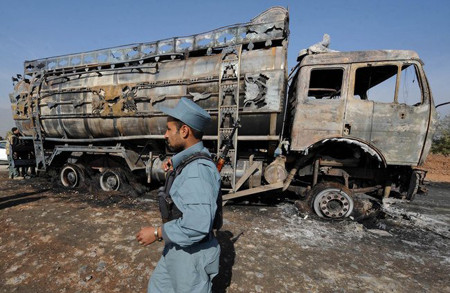By Sangar Rahimi and Ray Rivera

The fuel tanker, which exploded in Parwan Province, Afghanistan, was carrying several tons of fuel bound for NATO forces at Bagram, the coalition's main airbase. (Photo: Shah Marai / Agence France-Presse - Getty Images)
DASHT-E-RABAT, Afghanistan — A fuel tanker with a bomb hidden on board exploded Tuesday night on the road to Bagram Air Base, setting off an inferno that killed at least 10 people and left dozens more badly burned, many critically, local officials and witnesses said.
The explosion happened in Parwan Province, about 35 miles north of the capital, Kabul, just one day before Afghan officials were to list the province as one of 17 areas under consideration for the second stage of security transition from NATO to Afghan control. It was the latest in a series of insurgent attacks in recent months in what had been the quiet provinces surrounding the capital.
The tanker was carrying several tons of fuel bound for NATO forces at Bagram, the coalition’s main air base and the logistical hub for military operations throughout Afghanistan. Local officials said they believed that the base, about 10 miles from this village, was the intended target and that the bomb detonated prematurely.
The blast rattled homes just as villagers here were sitting down for dinner, around 7:30 p.m., and punched a hole through the back of the truck’s storage tank. Instead of igniting, however, the fuel gushed out into a dry water channel on the side of the road. As villagers raced to the scene, many with buckets to collect fuel, the gasoline exploded into a fireball four stories high, enveloping dozens of men, women and children.
Abdul Hay, a 25-year-old farmer, had just filled up two buckets with gas and run them to his home nearby when he heard the second explosion.
“I heard a big boom, and the area became like daylight,” he said. “When I got back to the area, I saw tens of our villagers with burning clothes running from the area and shouting for help and water.”
Dr. Ghulam Sakhi Kargar, a spokesman for the Afghan Public Health Ministry, said that in addition to the dead, at least 45 people were wounded in the blast, more than half with burns over 70 to 80 percent of their bodies.
Several villagers said the second explosion happened when the truck driver, either on orders from the police or of his own accord, tried to start the vehicle after the initial blast, sending a spark through the exhaust that ignited the fuel. The truck driver fled the area, witnesses and officials said.
In his hospital bed in Kabul, where bandages covered all but his eyes and mouth, Mohammad Shah, 24, said he and his brother were filling buckets with fuel from the back of the truck when it ignited.
“My clothes were soaked with fuel and caught fire,” he said. “I ran as much as I could and took off all my clothes and then fell unconscious. When I opened my eyes, I was here in the hospital.”
His brother was in the bed beside him, still unconscious and in critical condition. The explosion was at least the second major episode in the province since August, when suicide bombers attacked the provincial governor’s compound, setting off a three-hour gun battle that left 22 people dead.
Before that attack, the province had been among the more peaceful in the country and a prime candidate for transition. It was not immediately clear if this latest explosion would have any bearing on President Hamid Karzai’s and NATO’s final decision.
Two senior NATO officials said the second transition stage would put Afghan forces in the lead for maintaining security for nearly half the country’s population, though coalition troops would continue to play a major role in many of the areas.
Afghan security forces assumed the lead for seven areas, including the capital, in July in the first phase of what is expected to be five transition phases before American forces pull out the majority of their combat troops at the end of 2014.
Sangar Rahimi reported from Dasht-e-Rabat, and Ray Rivera from Kabul, Afghanistan.



